11 Most Endangered, 2011
4722 Tennesee Avenue, Dutchtown Neighborhood
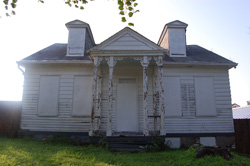 |
| 4722 Tennesse Avenue |
This frame central passage dwelling was likely constructed circa 1873 after Frank Ambs purchased the lot where it stands and several others in the surrounding South St. Louis Suburb Subdivision. Ambs was a German immigrant who earned his living as a market gardener farming the adjacent lots surrounding his home and selling his produce at several local markets. The development of the hall/parlor house separated by a central passage reflected new demands of privacy in the United States during the 19th century. The design allowed a homeowner to control the access from the public space of the hall to the more private settings of the chambers and parlor. This dwelling form and the fact that it is an early building of frame construction make it a rare property type in the City of St. Louis. The owner of the property, New Life Evangelical Center, is seeking to sell the land and the realtor believes that demolishing the home would make the property more marketable.
AAA Building - 3917 Lindell Boulevard, Central West End
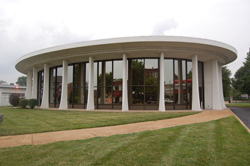 |
| 3917 Lindell Boulevard |
A building permit was issued in 1976 to the American Automotive Association (AAA) for the construction of a one story commercial building. The organization hired Peruvian-born architect, W.A. Sarmiento to design their new branch office in St. Louis. Formerly, Sarmiento was the chief designer for the St. Louis based Bank Building and Equipment Corporation (BBEC) from 1951 until 1961. During his ten year employment, Sarmiento designed a large number of banks across the nation. His design philosophy was based upon creating a new architecture for the 21st century reflecting the evolution of art and engineering rather than the revision of historical themes. At the end of his tenure with the BBEC, Sarmiento started his own firm and remained in St. Louis until 1978 before moving to California. Today, developers from Indiana have proposed demolition of the building to make way for a CVS chain pharmacy. The scheme was approved by the St. Louis Planning Commission with a 5-3 vote on July 6th. The AAA Building is not situated in either a historic district or preservation review district and lacks protection from unwanted demolition. Alderman Terry Kennedy states that he is neither for, nor against the demolition, but rather wants any development plan to reflect the interests of his ward.
Bethlehem Evangelical Lutheran Church - 2153 Salisbury Street, Hyde Park Neighborhood
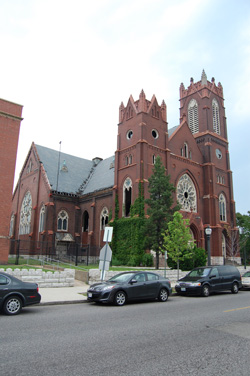 |
| 2153 Salisbury Street |
Bethlehem Evangelical Lutheran Church is located in the Hyde Park Historic District and suffers extreme disrepair due to neglect and lack of funds for maintenance. Many of the building's stained glass windows are missing, and the roof is crumbling. The church, completed in 1893, was designed by Louis Wessbecher. The building burned shortly afterward, but was reconstructed in 1895 using Wessbecher's original plan. The property remains under ownership of the Lutheran Church though services are held in the adjacent school building. Unfortunately, many parts of this stunning building, a landmark for over a century in Hyde Park, are open to the elements. Even simple fixes like boarding the windows would have a positive impact and help the Hyde Park community, which has seen an upswing in investment and interest in recent years, retain this critical piece of its architectural and historical character.
Brownhurst - 1201 South Kirkwood Road, Kirkwood, MO
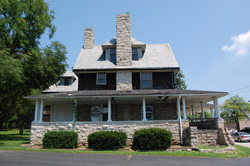 |
| 1201 S. Kirkwood Road |
Daniel Sidney Brown was born in St. Louis in 1854 to William and Mary (Cox) Brown. William was the founder of the Pioneer Cooperage Co., and by 1912 his son Daniel was Vice President of the company and in charge of the St. Louis operation. Around 1890 Brown commissioned "Brownhurst" this rare and beautiful Richardsonian shingle style home in Kirkwood, where he had moved from St. Louis in part to pursue his lifelong avocation of horticulture. On this property he grew many species of flowers, palms, ferns and orchids and eventually came to manage forty acres of greenhouses and gardens. Brown's gardens were so renowned that they became a popular day trip and side-attraction for visitors to the World's Fair. By the 1910's Brown had begun to donate specimens to the Missouri Botanical Gardens and in 1918 he essentially donated his entire collection of rare plants to the organization. Around 1918, he sold Brownhurst and the property to the Society of Mary, also known as the Marianists, who today operate Vianney High School on the land. The building has been empty since 1989 and has been left open to decay for years leading to accurate accusations of demolition-by-neglect from critics in Kirkwood and St. Louis County. A National Register nomination of the property is currently underway, and demolition has been delayed by the Kirkwood Landmarks Commission, though it does not possess the authority to prevent it altogether.
Hodgen School - 2748 Henrietta Place, The Gate District
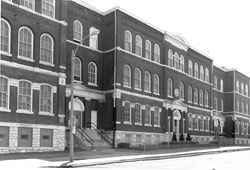 |
| 2748 Henrietta Place |
The St. Louis Public School System announced plans in January of 2011 to demolish the historic Hodgen School on California Avenue to make way for more parking and playground for the newer Hodgen Elementary School directly to its west. Constructed in 1884, Hodgen is the only known extant school designed by prominent St. Louis architect Otto J. Wilhelmi. Determined eligible for the National Register of Historic Places thanks to an eligibility assessment submitted by our friends at the Preservation Research Office, sale and redevelopment of this building could earn money for the cash-strapped SLPS. Instead, the proposed demolition will presumably be paid for using some of the $150 million raised by Proposition S, which was approved by City voters for the repair and improvement of school buildings. Money for demolition was not part of the deal. A Landmark in the "Gate District" and a unique example of a Wilhelmi school, Hodgen underwent a nearly half-million dollar renovation in the late 1990's, only to be abandoned a few years later following the construction of the new school in 2001.
Loler House - 2137 N. St. Louis Avenue, St. Louis Place
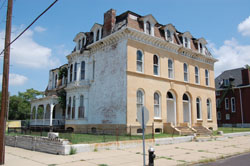 |
| 2137 N. St. Louis Avenue |
The dwelling at 2137 N. St. Louis Avenue was constructed c. 1870 for an Irish immigrant and former steamboat captain John Loler. Likely the earliest extant home in the St. Louis Place National Register District, the elegant Italianate style dwelling has significantly deteriorated in recent years. Unfortunately, many of the Loler home's windows on the side and rear elevations are open to the elements and the home does not appear to be occupied leaving the magnificent building highly vulnerable to both deterioration from the elements as well as the scourge of brick theft which has decimated the surrounding area in recent years.
3036 Coleman Avenue, Maplewood, MO
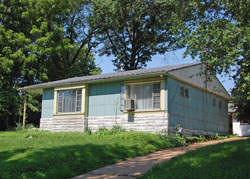 |
| 3036 Coleman Avenue |
The Lustron house at 3036 Coleman was assembled in 1949-construction probably took no longer than five days. Lustron houses were developed after World War II by Carl Strandlund of the Lustron Corporation, a division of the Chicago Vitreous Enamel Corporation. Designed to be virtually maintenance free for busy baby-boom families, the homes are constructed of enameled steel panels which are termite-proof, fire-proof, and rust-proof, and can be washed easily with a garden hose. Advertised as "ranch homes with a refrigerator finish" Lustrons came in many different pastel colors, and in 1949 they sold for around $8,500. The one at 3036 Coleman is a pastel blue model # 02, and was first occupied by Russell L. Bentley. Only about 3,000 homes were constructed between 1948 and the company's bankruptcy in 1950, and only an estimated 2,000 remain today. The home is threatened with demolition for a car dealership.
Oak Grove Mausoleum - 7800 St. Charles Rock Road, Unicorporated North County
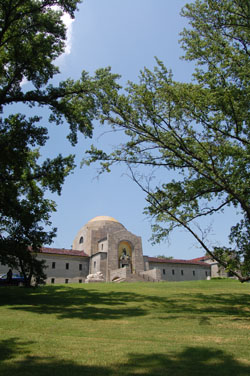 |
| 7800 St. Charles Rock Road |
The Oak Grove mausoleum, constructed in 1928 (with later additions in the 1930s), is attributed to architects Tom P. Barnett and Sidney Lovell. The building was recently used as the site of Missouri Preservation's 2011 Most Endangered Historic Properties announcement venue. Vandalism has stripped the mausoleum of original exterior copper details, and deferred maintenance has resulted in extensive interior mold and water damage. We hope that the non-profit organization in charge of the building will be able to successfully stabilize and restore the Byzantine style mausoleum, though funding issues remain a major hurdle.
Rock Hill Presbyterian Church - 9407 Manchester Road, Rock Hill, MO
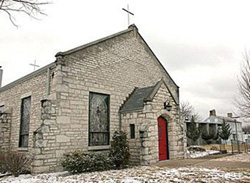 |
| 9407 Manchester Road |
In 1845, James Collier Marshall donated a portion of his 900 acre farm at what was then the terminus of the Rock Hill Road at what is now Manchester for the construction of a Presbyterian church. Marshall, a native of the tidewater region of Maryland, directed his slaves to build the church of limestone quarried from the property. The church and adjacent residence of Marshall, known as the Fairfax House, were the genesis of the village of Rock Hill. The current site of the church and residence were purchased by U-Gas, a local gas station chain. U-Gas plans to demolish the Rock Hill Presbyterian Church and relocate the Fairfax House to make way for a gas station and car wash. The site plan initiating demolition and relocation was approved by the Rock Hill Board of Aldermen and the Planning and Zoning Commission in July. Currently there is a six-month waiting period before demolition can proceed, which is designed to allow time for a plan to materialize to save or move the church.
St. Elizabeths Academy - 3401 Arsenal Street, Tower Grove East
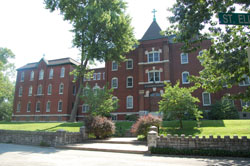 |
| 3401 Arsenal Street |
St. Elizabeth's Academy has had a presence at its current location in Tower Grove East since the Sisters of the Most Precious Blood of O'Fallon Missouri opened a boarding school for girls in a building at the rear of the Joseph Schiller home in 1882. The Schiller family had settled on the land in 1851 and planted a vineyard which became a popular destination for Sunday outings among south side Germans. The school was patronized primarily by affluent German Catholics in the area as a finishing school, and later a college preparatory academy for girls whose parents wanted them educated beyond eighth grade. Following the death of Mrs. Schiller in 1892, the Sisters hired the firm of Joseph Stauder & Son (noted architects of St. Agatha's church in Soulard and the Sister's Mother House in O'Fallon), to design a new school building, completed in 1894. This building forms the visual focus of the eastern end of what is today the Crittenden National Register District. The school was enlarged with a north wing in 1914 and a south wing and chapel in 1922. In 1927 a unique gymnasium was constructed at the eastern edge of the campus featuring one of the first lamella roofs (a vaulted roof supported by a crisscrossing pattern of parallel arches composed of short members (lamellae) hinged together to form an interlocking, diamond pattern) constructed in St. Louis. Currently the school is raising funds to implement a master plan which includes the demolition of all four historic components of the campus and a renovation of the 1957 school building. Not only would this course of action destroy the material history of the school's presence at the site and its unique character (advantages it has over more modern institutions), it would leave a gaping hole in the center of Tower Grove East, and potentially result in the de-listing of the Crittenden District from the National Register.
212 S. Grand Boulevard, Midtown
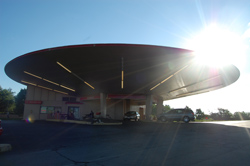 |
| 212 S. Grand Boulevard |
The "flying saucer" of South Grand, constructed in 1967, originally housed a gas station and is one of four contributing buildings in the Council Plaza Historic District. Constructed for the Teamsters Local 688, Council Plaza was designed as a total concept community, providing residential, retail, office space, a restaurant, and medical and automotive services for tenants. According to an interview conducted by Landmarks' Preservation Specialist Ryan Reed, Richard Henmi, chief designer of the project, wanted the gas station to deviate from the geometric simplicity of the surrounding high and low rises and be the centerpiece of the plaza. On June 21st, the building was deemed blighted by the St. Louis Land Clearance and Redevelopment Authority. This designation paved the way for demolition of 212 South Grand without review by the Cultural Resource Office (CRO). After a tremendous outcry from the general public, the bill allowing the demolition of the building was amended stipulating review by the CRO. However, the developer had stated several times the building was not a good candidate for redevelopment and that he would prefer demolition and new construction. Due to public protests, the developer has decided to retain the building and hired the architecture firm of Klitzing Welsch to bring the building back to its original luster. Rick Yackey, the developer, has been holding monthly meeting at 212 S. Grand to update the public on the progress of the redevelopment.
